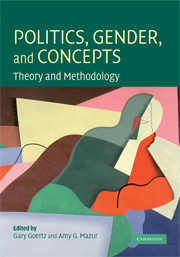Book contents
- Frontmatter
- Contents
- List of figures
- List of tables
- Notes on contributors
- Acknowledgments
- 1 Introduction
- 2 Mapping gender and politics concepts: ten guidelines
- Part I Gendering Concepts
- Part II Gender-Specific Concepts
- 8 Gender ideology: masculinism and feminalism
- 9 Intersectionality
- 10 Women's movements, feminism, and feminist movements
- 11 State feminism
- Appendix: A website for additional gender and politics concepts
- References
- Index
9 - Intersectionality
Published online by Cambridge University Press: 06 July 2010
- Frontmatter
- Contents
- List of figures
- List of tables
- Notes on contributors
- Acknowledgments
- 1 Introduction
- 2 Mapping gender and politics concepts: ten guidelines
- Part I Gendering Concepts
- Part II Gender-Specific Concepts
- 8 Gender ideology: masculinism and feminalism
- 9 Intersectionality
- 10 Women's movements, feminism, and feminist movements
- 11 State feminism
- Appendix: A website for additional gender and politics concepts
- References
- Index
Summary
The concept of intersectionality is an important contribution of feminist theory to the general endeavor of understanding society and politics. The concept is especially valuable for those scholars (such as critical theorists) who aim to critically evaluate social relations, exposing relations of domination, or “speaking truth to power.” As I explain below, the concept originates in efforts of Black feminists in the United States to theorize about their experiences and social position, but I argue in this chapter that the concept has great potential to illuminate other national contexts as well. The concept confronts an important dimension of social complexity: the interaction between social structures such as race, class, and gender (among others). Like many important concepts, however, there are multiple ways of understanding and applying the concept of intersectionality. I argue that one of these ways of understanding the concept, an approach I call the intersectionality-only approach, makes the concept harder to operationalize and less able to travel, while another possible interpretation, the intersectionality-plus version, renders the concept more useful for research, especially cross-national research, and is truer to the core elements of the concept. I use the guidelines for conceptual analysis to highlight these differences.
What is intersectionality? The context of the concept
Intersectionality is a concept that describes the interaction between systems of oppression. The concept grew out of efforts to specify how race and gender relations shaped social and political life.
- Type
- Chapter
- Information
- Politics, Gender, and ConceptsTheory and Methodology, pp. 193 - 218Publisher: Cambridge University PressPrint publication year: 2008
- 67
- Cited by



